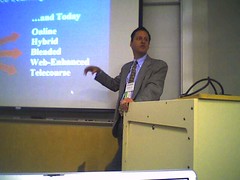 Cameron Cox is with In-Tell-com. The session is called “Enhancing Online and Blended Courses With High-Quality Video.” Frankly, it’s not the kind of session that I would normally sit in on, but I’m learning a lot here, from conversations that I normally do not sit in on. Some of the types of online teaching and learning include: online, hybrid, blended, web-enhanced, and telecourses. He ran through definitions and distinctions, but they really didn’t connect for me.
Cameron Cox is with In-Tell-com. The session is called “Enhancing Online and Blended Courses With High-Quality Video.” Frankly, it’s not the kind of session that I would normally sit in on, but I’m learning a lot here, from conversations that I normally do not sit in on. Some of the types of online teaching and learning include: online, hybrid, blended, web-enhanced, and telecourses. He ran through definitions and distinctions, but they really didn’t connect for me.
They produce courses that consist of video lessons with closed captioning. The videos are segmented or chaptered. They also produce eContent, authoring in HTML and WebCT and Blackboard.
They are now integrating audio-described video, captioning video with audio descriptions for visually impaired. Cool!
Many of the people at this conference are involved in community colleges, and many of their students do not have access to the latest technology. Many do not yet have a broadband, or even a DVD. So they still have to produce VHS video for distance learning.
The impression that I’m getting at this point, is that their product is designed for one-way content delivery. I’m sure that discussions are integrated in. But there’s not indication that students can do anything with the content or media.
Cameron just pointed out that customers can digital encode analog video that they have licensed. The can also identify specific segments, as long as the entire program is also made available. I understand this from the perspective of license agreements with content producers. I just learned, by asking what I’m sure sounded like a dumb question to the rest of the attendees, that teachers can re-sequence the segments, repurposing the lesson for their students.
Now, if only the students could remix the content to make their own learning lessons.
The plan to have, in the future, a depository of massive footage that they have, but have not included in their lessons. What I’m hearing is content raw-material that teachers can use to make their own lessons. This is where we need to be going, in my humble opinion.
